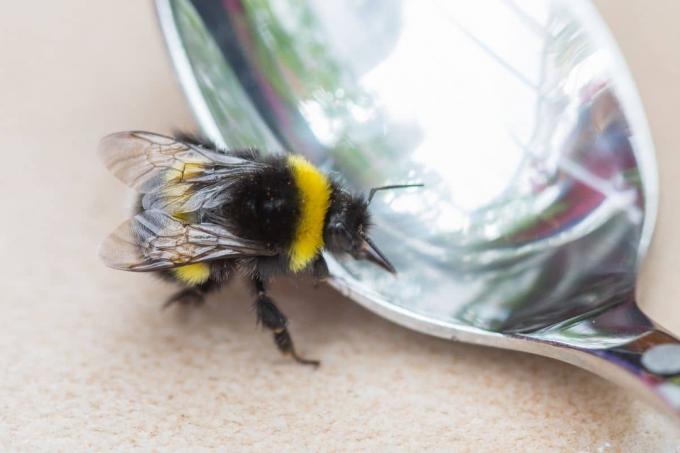
table of contents
- Bumblebee dieback: causes
- Bumblebees help
- Emergency solution: sugar water
- frequently asked Questions
Dead bumblebees under linden trees are a typical sight in high and late summer when the trees are in full bloom. This article will tell you what causes bumblebee deaths.
In a nutshell
- Linden trees are often the only source of food in midsummer
- are visited by numerous bumblebee colonies
- The linden tree's food supply is decreasing sharply
- Bumblebees die due to the following lack of food
- Bumblebee pastures help out the insects
Bumblebee dieback: causes
What causes the bumblebee death in July, which lasts all through high and late summer? If you are also wondering why there are so many dead bumblebees under linden trees, you need to look at the food supply. Bumblebees (Bombus) do not find enough late-blooming food sources in cities over the middle and late summer and starve to death. For this reason, whole colonies gather around two species of linden specifically:
- Silver linden (Tilia tomentosa)
- Crimean lime (Tilia euchlora)

Because of their resistance to drought and pollutants, the two species are preferred to be planted in urban areas along roads. They bloom after the summer linden (Tilia platyphyllos) and winter linden (Tilia cordata), which makes them an important supplier of food for bees and Bumblebees Makes mid-July to mid-August.
The disadvantage: Numerous bumblebee colonies visit the trees, which uses up the nectar and pollen much faster. Since the insects often travel long distances to the trees and have to compete for the available food, they die directly in the tree or on the way back to the nest. Since the peoples hardly stock up on supplies, many workers even perish on the way to the trees. This is why bumblebee dieback is so extensive. Other causes are:
- "Empty" linden trees are preferred to new traditional plants
- other food sources too far away
- There is a lack of food outside of cities

Note: The dark bumblebee (Bombus terrestris) is particularly hard hit by this problem. It is particularly difficult to adapt to new forage plants, which leads to the loss of numerous colonies.
Bumblebees help
If you live in the city and want to help the pollinator insects, you need to provide them with additional sources of food. To do this, rely on bee- and bumblebee-friendly plants that don't bloom until later in summer. It doesn't matter whether you have a garden, courtyard or balcony. Even a balcony box with richly flowering species is sufficient to provide a large number of bumblebees with food. The following crops are best suited for this purpose:
- Artichoke (Cynaria scolymus)
- Beard flowers (Caryopteris)
- Common heather (Calluna vulgaris)
- Bee friend (Phacelia tanacetifolia)
- Blue adder's head (Echium vulgare)
- Real lavender (Lavandula angustifolia)
- Common ivy (Hedera helix)
- Clover (trifolium)
- Cornflower (Cyanus segetum)
- Globe thistles (Echinops)
- Mallow (Malva)
- Oregano (Origanum vulgare)
- Rudbeckia (Rudbeckia)
- Hollyhocks (Alcea)
- Buddleia (Buddleja davidii)
- Sun hats (Echinacea)
- Dead nettles (lamium)
- Wasserdost (Eupatorium cannabinum)

Emergency solution: sugar water
They can give a little boost to exhausted bumblebees if you can find them on your property. Just mix in a little sugar water and feed the insects. They recharge their energy reserves through the meal. All you need for this is half a teaspoon of sugar, which you dissolve in water at room temperature. The jump start is administered as follows:
- Move the bumblebee to a safe place
- transport carefully on paper or the like
- also possible by hand
- Pour sugar water into teaspoons
- place directly in front of bumblebee
- on average 1/3 of sugar water is drunk

Note: Sugar water is only an emergency solution if you have already designed your garden to be bumblebee-friendly. If the bumblebee finds only heavily frequented linden trees after the sugar meal, it again consumes too much energy and dies.
frequently asked Questions
Bumblebees are more and more common in cities as the food supply in rural areas is decreasing and being replaced by monocultures. Late-blooming plants in particular are becoming increasingly rare, which makes moving to urban areas attractive. Since many cities rely on Crimean and silver linden, they are often the only available energy source for the insects.
Yes. Bees of all kinds also fly to the linden trees and die, depending on the food available. However, since bees are not so focused on certain forage plants, they quickly find other plants that serve as a source of food. For this reason there are significantly fewer dead bees than bumblebees under the linden trees.
Predators are a common problem for the weakened insects, as they can no longer escape them due to the lack of energy reserves. Wasps, hornets and birds, which have easy play with bumblebees, are particularly problematic in late summer.
Researchers previously suspected that the cause of the massive death of the pollinators could be mannose. Mannose is a sugar that is toxic to bumblebees and bees. However, mannose is not found in Linden nectar, which contradicts this theory.


